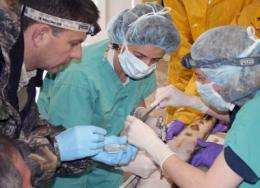Lake sturgeon have genes from parasite, signs of human STD

While trying to find a DNA-based test to determine the sex of lake sturgeon, Purdue University researchers found that the sturgeon genome contains trematode genes that didn't originally belong to it and may harbor a protozoan parasite that causes a sexually transmitted disease in humans.
Genetics professor Andrew DeWoody and postdoctoral associate Matthew C. Hale found the parasite and pathogen genes while analyzing DNA from the gonads of lake sturgeon, a species that is on the decline because of overfishing and pollution of its habitats. The only way to determine a lake sturgeon's sex currently is to examine its internal sexual organs.
DeWoody said about 15 genes found in the lake sturgeon came from Schistosoma, a parasitic worm. Lateral gene transfer from one organism to another is rare, especially in multicellular animals, he said, but could be part of some evolutionary process for the sturgeon.
"Organisms may accept some new genes from other species because the new genes can serve as raw material for evolution," said DeWoody, whose findings were reported in the early online version of the journal Genetica. "The genome may be more fluid than we usually think."
Hale said genes often work in combination, and new genes may one day become involved with other genes to help the lake sturgeon create new traits needed to adapt to changes in its environment.
"It isn't necessarily a bad thing for the sturgeon. It probably doesn't have a cost," Hale said. "It's either neutral or has a benefit or it wouldn't be there."
While lateral gene transfer from a trematode worm could ultimately benefit the lake sturgeon, evidence of the Trichomonas pathogen is more likely to have a negative effect. According to the Centers for Disease Control and Prevention, a human version of this pathogen causes Trichomoniasis, a common sexually transmitted disease that mostly affects women and can cause pregnant women to deliver early or have children with lower birthweights.
The finding is the first suspected case of Trichomonas in a fish, DeWoody said. While it's unclear how the parasite might affect lake sturgeon, DeWoody said it could negatively impact the fish's reproductive ability, which is especially alarming in a species of conservation concern.
"If it has the same effect in lake sturgeon as it does in humans, that wouldn't be good," he said.
Since lake sturgeon populations are declining and endangered in some places, a less invasive procedure to determine sex would be valuable for those studying lake sturgeon and potentially other species of sturgeon that are similarly threatened. DeWoody and Hale were able to identify a gene thought to play a role in sex determination, but it was found to be expressed in both males and females.
Next, DeWoody and Hale would like to determine the effect - if any - the Trichomonas parasite has on lake sturgeon.
Hale said lake sturgeon can live more than 100 years, and females do not reach sexual maturity for more than 20 years. Even then, they only lay eggs about every five years. Understanding how a pathogen or humans are affecting the sturgeon could be key to conserving them.
"Humans can have an effect very quickly and very easily on the sturgeon population," Hale said.
Provided by Purdue University














